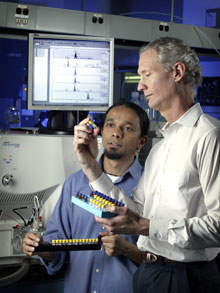Tollbooth Ventilation System Effective in Protecting Workers from Traffic Air Pollution
Although there is the potential for tollbooth workers at the Baltimore Harbor Tunnel to be exposed to high levels of cancer-causing air toxins emitted from the thousands of vehicles that pass under their nose, researchers from the Johns Hopkins Bloomberg School of Public Health found that the tollbooth ventilation system was effective in keeping air toxins out of the tollbooth and away from the workers. The researchers measured levels of volatile organic compounds (VOCs) and particle-bound polycyclic aromatic hydrocarbons (PAHs) inside and outside the tollbooth and found relatively high levels outdoors and relatively low levels indoors. The study is published in the May 1, 2005, issue of Environmental Science & Technology.

Amir Sapkota and Timothy J. Buckley
“Tollbooth facilities represent a potential worst-case scenario for occupational exposure to mobile source-related air pollution, as these employees spend a majority of their shift within an arm’s length of thousands of vehicles emitting a wide range of toxic pollutants. Yet, little has been done to evaluate worker exposure and the protection afforded by the indoor environment,” Amir Sapkota, PhD, lead author of the study and a post-doctoral fellow in the Bloomberg School of Public Health’s Department of Environmental Health Sciences.
In June 2001, the researchers measured the concentration of air toxins at a tollbooth at the Baltimore Harbor Tunnel. They also examined traffic volume in addition to curbside pollutant concentrations and the concentrations inside the tollbooth. They compared air toxin levels during the three shifts worked by tollbooth employees—morning (6 a.m.–2 p.m.), afternoon (2–10 p.m.) and night (10 p.m.–6 a.m.).
The researchers found that levels of 1,3-butadiene and benzene peaked with the morning and afternoon rush-hour traffic. In contrast, they found that the levels inside the tollbooth were relatively low and constant. They found, however, that some of the chlorinated VOCs used in dry cleaning, air deodorizers and cleaning products were present in higher concentrations inside the tollbooth than outdoors.
“It is wonderful to discover that the tollbooth environment is doing what it is designed to do—protect workers from the hazardous environment in which they would otherwise be immersed. It is important to note, however, that not all tollbooth workers in this country, and especially in developing countries, are provided with this protection,” said Timothy J. Buckley, PhD, MHS, senior author of the study and an associate professor in the Bloomberg School of Public Health’s Department of Environmental Health Sciences.
“Tollbooth Workers and Mobile Source-Related Hazardous Air Pollutants: How Protective Is the Indoor Environment?” was supported by the Johns Hopkins Education and Research Center Pilot Project Research Training Fund, National Institutes of Environmental Health Sciences and U.S. Environmental Protection Agency.
Co-authors of the study were Amir Sapkota, D’Ann Williams and Timothy J. Buckley.
Public Affairs media contacts for the Johns Hopkins Bloomberg School of Public Health: Kenna Lowe or Tim Parsons at 410-955-6878 or paffairs@jhsph.edu. Photographs of Timothy J. Buckley and Amir Sapkota are available upon request.